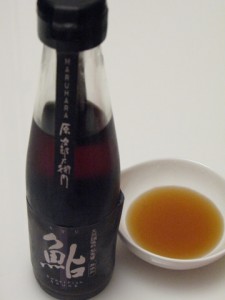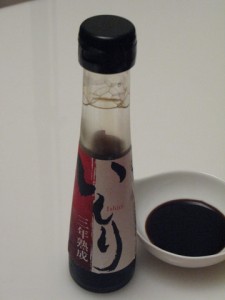Last week while making a gastronomic tour – jorneying from one restaurant to another – in one of my favorite places, the city of Barcelona, I encountered an intriguing food history site – a place where Romans produced garum, a fermented fish sauce, when they occupied the city 2000 years ago. Records and documents indicate that this sauce was a key, highly regarded ingredient of Roman cooking. It was so valued that it was often given as a gift, like the bottle of wine you give to your host at a dinner party. The subterranean archaeological site excavated from beneath the present-day city shows us a complete garum production site from the fish storage and cleaning areas to the large clay pots that were half buried into the ground for fish sauce production. The sign at the museum states that the Roman garum was flavored with oysters, some shrimp and herbs. From this description I believe that it probably tasted very good. But, as far as I know garum or a similar successor does not exist in today’s Spanish cuisine. After this fascinating tour I asked many local food experts, including professors at Escuela Hofmann in Barcelona, the city’s most well-known cooking school and Escuela de Luis Irizar in San Sebastian, one of the highest regarded culinary academies in Spain questions about the disappearance of this umami (umami: check the previous umami blog) rich fish sauce from Spasnish culinary culture. Why did it so completely disappear when the Romans left not just from Spain but every country and region of their empire? No one could offer me the answer. Thus far I have been able to find much information on the Web about garum, but no information on why it so completely vanished from the place subdued and occupied by Rome. If you know the answer, I would really like to know.
Top: Ayu fish sauce (made from ayu fish), bottom: ishiru (made from squid intestines)
Seeing the garum production facility and thinking about it calls to mind a story about Japanese fermented fish sauce. The most representative Japanese fish sauce is shottsuru made in the northern part of Japan, Akita Prefecture. Shottsuru fish sauce is traditionally produced by fermenting hatahata (Japanese sand fish; take a look at the fish at https://www.tsukijiexpress.com/detail?id=01t30000001zY22AAE), salt, rice, koji (aspergillus oryzae; the starter mold for fermenting rice to make sake, miso,…), kelp, carrot and yuzu citrus fruit. The process takes at least two years. Koji breaks down protein into many amino acids and carbohydrates into various sugars and organic acids, creating a flavorful, aromatic and nutrisious fish sauce. Locals use this traditional sauce to flavor their hot pot dishes. Another famous fish sauce, ishiru, is made from fermenting squid intestines with salt for about one year. It has distinctive flavor, aroma and lots of umami. The popularity of ordinary soy sauce, shoyu, made from fermenting soybeans and wheat, has to some extent prevented for these fish sauces from coming onto the main stage of Japanese cooking. And so until quite recently they have remained as local regional favorites. Today some producers have found a broader market for this fish sauce that is growing and attractive because cooks have begun to recognize the umami rich character of the sauce. Maruhara Company in Ohita Prefecture, a business that has been producing shoyu and miso for hundred of years, came up with the idea of producing fish sauce using local ayu sweet fish, ten years ago. Ayu is a river fish that is said to have a “watermelon like”, refined flavor. Today, using ayu the company produces one of the most tasty fish sauces in Japan, and this fish sauce is available in USA (for commercial order, contact Yuji at haraguchi@trueworldsfoos.com or call him at 646-212-1358). The story of Japanese fish sauce continues to my next post, and I will also have more to say about ayu. For those who are interested in discover moreTsukiji fish, visit at www.tsukijiexpress.com.


